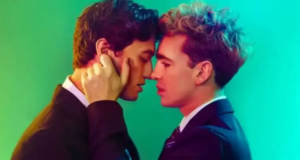An extremely well-judged adaptation of A Christmas Carol that evokes Dickens' own public readings of the story.Summary
Rating
Good
Scrooge’s former business partner Jacob Marley only makes a brief appearance in Charles Dickens‘ novella A Christmas Carol as a prophesising nightly apparition, but in James Hyland‘s adaptation, Marley’s ghost is our omniscient and sole narrator.
After dragging himself and several chains from the afterlife into the upstairs room of the White Bear pub theatre, Jacob Marley (played by Hyland) delivers his lines with growls, loud wailing and a low, booming and terrifying pitch that would not been out of place in an open-air Graeco-Roman amphitheatre.
The whole scene consists of a single chair and hot-to-the-touch key strung across its back that will eventually unlock Jacob’s padlock and release his chains. After the chains fall, the whole story is told, each character convincingly played in turn by the ghost, who mimics their different voices and mannerisms to assist the audience to flit quickly from ghost-as-narrator to ghost-in-character as the events unfold.
This adaptation works very well: the duration is perfect for a winter fringe theatre night and the key moments of the story are well chosen. The actual delivery, however, ricocheted against the low ceiling and white bare walls of the intimate theatre, hitting the audience harder and louder than required: a simple mismatch of venue and delivery style that does not detract from the quality of the production itself.
As this adaptation centres on a ghost’s retelling of the story and acting all the parts in turn, a few considerations about ghosts as a plot device are in order. Firstly, as to appearance, ghosts generally tend to fall into one of two tropes: those that whisper in echoes and move at the margins of the stage shrouded in floating white robes, and those that howl, stomp ponderously across the boards in chains and sooty garb, often marked by some physical deformity. A well-appointed, trim and clean-shaven ghost is a stage rarity. Here, Hyland’s ghost does not escape the stereotype: Marley’s ghost is dressed in grubby, ripped and ill-fitting waistcoat and breeches, added contact lenses mimicking permanently dilated pupils, and is finished off with blackened teeth, ashen hair and face makeup. The actor’s own presence is very physical, indeed: no hint of evanescence or whispers. He growls, he thumps and, if the set had any, we’d probably see him slam doors rather than walk through them. It is not clear that this physical manifestation of our narrator ghost adds much to the story while, perhaps, it reduces its appeal to audiences with very young children.
Secondly, as to acting style, one wonders if, perchance, this adaptation is closer to the taste and expectations of a Victorian audience than of a contemporary one. It is well documented that Dickens gave numerous public readings of A Christmas Carol in his lifetime. Equally well documented is how Dickens mastered in his youth the monopolylogue craft, where a single actor delivers the lines of all the characters in the story, marking each through a different pitch, mannerism or accent. One can make the educated guess that, in his reading tours, Dickens himself would have made use of this demanding acting technique, so remarkably brought to us by Hyland. To a contemporary audience, however, this style of delivery both dabbles in uncomfortable stereotypes (cockney for those on low wages, demure and trembling for female voices), and comes across as over-acting.
This is a solid adaptation and an entertaining performance from Hyland, but perhaps it is a little anachronistic in form. I can’t help but wonder if such a production would be better marketed as a period piece; one in line with a respected performing style in vogue through the Victorian age?
Novella adapted by: James Hyland
Directed by: James Hyland
Produced by: Brother Wolf Productions
 Everything Theatre Reviews, interviews and news for theatre lovers, London and beyond
Everything Theatre Reviews, interviews and news for theatre lovers, London and beyond



